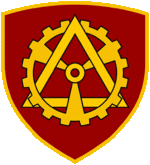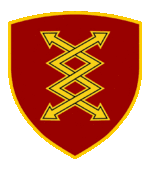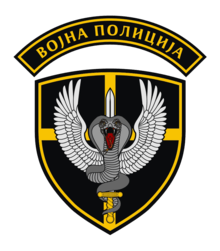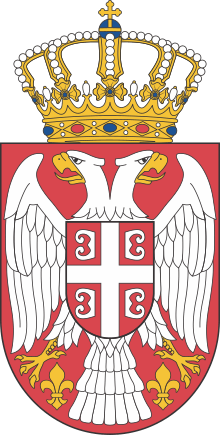Serbian Armed Forces
The Serbian Armed Forces (Serbian: Војска Србије, romanized: Vojska Srbije) form the armed forces of Serbia. The Armed Forces consist of:
- the Army
- the Air Force and Air Defence
- the Training Command
- the Guard
- the Special Forces - 72nd Brigade for Special operations and 63rd Parachute Brigade
| Serbian Armed Forces | |
|---|---|
| Bojcka Србије Vojska Srbije | |
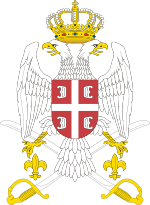 Emblem of the Serbian Armed Forces | |
| Founded | 6 May 1830 |
| Current form | 2006 |
| Service branches | Army Air Force and Air Defence |
| Headquarters | Ministry of Defence, Belgrade |
| Leadership | |
| Commander-in-Chief | President Aleksandar Vučić |
| Minister of Defence | Aleksandar Vulin |
| Chief of the General Staff | General Milan Mojsilović |
| Manpower | |
| Military age | 18 years of age for voluntary military service |
| Conscription | 30 days (limited circumstances) |
| Fit for military service | 3,573,091[1] males, age 16-49 (2010 est.), 3,537,415 females, age 16-49 (2010 est.) |
| Reaching military age annually | 43,945 males (2010 est.), 41,080 females (2010 est.) |
| Active personnel | 28,000 (2020)[2] |
| Deployed personnel | 336[3] |
| Expenditures | |
| Budget | $1.14 billion (2020)[4] |
| Percent of GDP | 1.75% (2019) |
| Industry | |
| Domestic suppliers | Yugoimport SDPR Zastava Arms Prvi Partizan Sloboda Čačak Krušik Valjevo Milan Blagojević - Namenska Utva Pančevo Fabrika automobila Priboj Zastava Trucks Others |
| Annual exports | $888 million (2018)[5] |
| Related articles | |
| History | Military history of Serbia |
| Ranks | Military ranks of Serbia |
The highest authority in the Armed Forces as well as in the defense system of the country, in-charge of the deployment and preparation of the Armed Forces in peace and war, is the General Staff. The President of the Republic acts as Commander-in-Chief of the armed forces. The Serbian Armed Forces are a professional- and volunteer-based military. Serbia exercises civilian control of the military through the Ministry of Defence.
The Serbian Armed Forces follow a doctrine of neutrality regarding political ideology.[6]
History
The Serbian Revolution of 1804 started with the First Serbian Uprising against the Ottoman occupation of Serbia. The victories in the battles of Ivankovac (1805), Mišar (August 1806), Deligrad (December 1806) and Belgrade (November-December 1806), led to the establishment of the Principality of Serbia in 1817. The subsequent Second Serbian Uprising of 1815-1817 led to full independence and recognition of the Kingdom of Serbia and weakened the Ottoman dominance in the Balkans. In November 1885 the Serbo-Bulgarian War occurred following Bulgarian unification and resulted in a Bulgarian victory. In 1912 the First Balkan War (1912-1913) erupted between the Ottoman Empire and the Balkan League (Serbia, Greece, Montenegro and Bulgaria). Balkan League victories in the Battle of Kumanovo (October 1912), the Battle of Prilep (November 1912), the Battle of Monastir (November 1912), the Battle of Adrianople (November 1912 to March 1913), and the Siege of Scutari (October 1912 to April 1913) resulted in the defeat of the Ottoman Empire, which lost most of its remaining Balkan territories per the Treaty of London (May 1913). Shortly after, the Second Balkan War (June to August, 1913) broke out when Bulgaria, dissatisfied with the division of territory, declared war against its former allies, Serbia and Greece. Following a string of defeats, Bulgaria requested an armistice and signed the 1913 Treaty of Bucharest, formally ending the war.
Serbia's independence and growing influence threatened neighboring Austria-Hungary which led to the Bosnian crisis of 1908–09. Consequently, from 1901, all Serbian males between the ages of 21 to 46 became liable for general mobilization.[7] Following the assassination of Archduke Franz Ferdinand of Austria in June 1914, Austria-Hungary implicated Serbians and declared war on Serbia (July 1914), which marked the beginning of the First World War of 1914-1918. Serbian forces repelled three consecutive invasions by Austria in 1914, securing the first major victories of the war for the Allies, but were eventually overwhelmed by the combined forces of the Central Powers (October-November 1915) and forced to retreat through Albania (1915-1916) to the Greek island of Corfu (1915-1916).
Serbian military activity after World War I took place in the context of various Yugoslav armies until the break-up of Yugoslavia in the 1990s and the restoration of the state of Serbia as a separate independent republic in 2006.
Organisation
The Serbian Armed Forces are commanded by the General Staff corp of senior officers. The general staff is led by the Chief of the General Staff. The chief of the general staff is appointed by the President who is the Commander-in-Chief. The current Chief of the General Staff is General Ljubiša Diković.
The armed forces are formally a part of the Ministry of Defence. The current Minister of Defence is Aleksandar Vulin.[8]
Unofficial reports on 14 Sept 2018 indicate that Prime Minister Aleksandar Vucic is planning to promote Major General Milan Mojsilovic, currently Assistant Minister of Defense Aleksandar Vulin, to the Chief of General Staff position. The same report indicates that the heads of all other military services, including the Special Forces brigade, will be changed.[9]
Service branches
The armed forces consist of the following service branches:
Serbian Army
The Serbian Army (including a River Flotilla on the Danube) is the land-based component of the armed forces consisting of: infantry, armoured, artillery, engineering, and special forces units.
Serbian Air Force and Air Defence
The Serbian Air Force and Air Defence is the aviation and anti-aircraft defence based component of the armed forces consisting of: aviation, anti-aircraft, surveillance and reconnaissance units.
Serbian Training Command
The Serbian Training Command was established on 23 April 2007, by merging parts of Operation Forces, Land Force and Air Force units. The Training Command is primary responsible for providing soldiers, non-commissioned officer and officers of SAF, as well the members of foreign armies basic and military specialist training.
Serbian Guard
The Serbian Guard is an honor guard unit of the Armed Forces of Serbia. The Guard is directly subordinated to the Chief of General Staff Office and performs duty of ceremonial guard during peacetime as well as strategic combat duties during wartime.
Units directly subordinated to the General Staff
As General Staff comprises various sections there are specific units that directly subordinate to the Staff such as[10][11],
Equipment
The comprehensive list of equipment is given in Equipment of the Serbian Armed Forces. It includes most of equipment in use and plans for modernization.
Reserve
The reserve force is composed of an active reserve and passive reserve. The active reserve force numbers 2,000 members,[12] while the passive reserve totals about 1.7 million citizens with past military training or experience.[12]
Traditions
.jpg)
The Serbian military was the first to pioneer the high-step as a military step. It is similar to the goose step, with the difference being that the knee is bent at the top of the arc. It originates from the Royal Yugoslav Army and at the time was called the male step. The Yugoslav People's Army abandoned it after World War II, being in use for over two decades before being replaced by high-stepping in the 1975 Victory Day Parade, to assert himself as independent from Soviet influence in the eyes of the Non-Aligned Movement. High-stepping is still used today in Serbia, and is also utilized by the militaries of North Macedonia and Bosnia and Herzegovina.
Peacekeeping
The Serbian Armed Forces actively take part in several multinational peacekeeping missions.[3]
| Country | Mission | Number of personnel |
|---|---|---|
| UNFICYP | 1 staff officer, 2 observers, 6 non-commissioned officers and 37 infantry | |
| MINUSCA | 3 staff officers, 2 observers, 68 medical infantry | |
| EUTM RCA | 7 medical infantry | |
| MONUC | 2 staff officers, 2 doctors and 4 technicians | |
| UNIFIL | 8 staff officers, 5 national support element and 164 infantry | |
| UNMIL | 1 officer as military observers | |
| EUTM Mali | 3 medical infantry | |
| Middle East | UNTSO | 2 officers |
| EUTM Somalia | Medical Corps team including 1 staff officer, 1 doctor and 3 medical technicians | |
| EUNAVFOR | 4 OHQ staff officers, 1 OHQ non-commissioned officer, 2 FHQ staff officers and 12 members of AVPD |
See also
- Military history of Serbia
- Military ranks of Serbia
- Military Security Agency (VBA)
- Military Intelligence Agency (VOA)
- Joint Operations Command (JOC)
- Peacekeeping Operations Center (PKOC)
References
- "The World Factbook".
- "Sa 28.000 vojnika Vojska Srbije među najbrojnijim u regionu". blic.rs (in Serbian). Tanjug. 2 February 2010. Retrieved 9 December 2017.
- "Министарство одбране Републике Србије - Актуелне мултинационалне операције".
- https://www.euractiv.com/section/all/short_news/serbia-had-the-highest-military-expenditure-in-2
- https://medium.com/@skunkworksLH/the-defense-industry-of-serbia-is-the-largest-in-the-western-balkans-5ac51f045baa
- O Vojsci at vs.rs
- "Serbian Army in WWI". Archived from the original on 2009-03-23.
- "Министарство одбране Републике Србије - Министар одбране".
- "Vucic to replace military brass, including army chief - English - on B92.net". B92.net. Retrieved 2018-09-15.
- http://www.vs.rs/sr_lat/jedinice/vojska-srbije/specijalna-brigada
- http://www.politika.rs/sr/clanak/444464/Ponovo-postoje-63-padobranska-i-72-specijalna-brigada
- "Iz stroja pravo na posao" (in Serbian). Večernje novosti. 22 March 2013. Retrieved 24 May 2014.
External links
| Wikimedia Commons has media related to Military of Serbia. |
